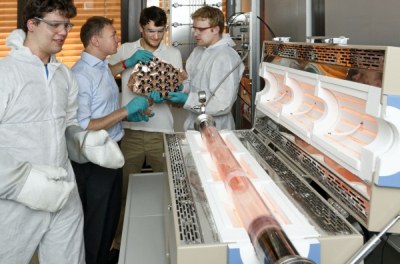Closing the performance gap between natural and synthetic graphene
Jülich–Aachen, 19. August 2015
Breakthrough in the production of high-quality synthetic graphene.
Scotch tape method outdated: Scientists at RWTH Aachen University and PGI-9 at Forschungszentrum Jülich have achieved a breakthrough in the production of high-quality synthetic graphene.
What started more than 10 years ago as an unconventional experiment by Andre Geim and Konstantin Novoselov - they used scotch tape to separate a single layer of graphene from a piece of natural graphite - has developed into a global field of research with billions of dollars invested. Graphene is also known as a "wonder material" because of its unique properties. It consists of a single atomic layer and is therefore very flexible, but at the same time extremely mechanically stable. Graphene is optically transparent and conducts electricity better than any other material. The combination of these properties is unique and thus technological breakthroughs can be achieved using graphene: Graphene has enormous potential for future touch screens, as well as applications in ultra-high frequency electronics and flexible optoelectronics.
One of the current major limitations with regard to the industrial application of graphene is its production: the "scotch tape method" is only applicable for research use, but completely unsuitable for mass production. The alternative was to synthesize graphene from simple and abundant chemical compounds such as methane, using chemical vapor deposition (CVD): the natural reaction between methane and a heated copper surface is used to produce large and flawless graphene flakes.
The CVD method is scalable and cost-effective. But graphene synthesized in this way was for a long time of significantly lower quality than natural graphene produced via the "scotch tape method", especially in the electrical range. This is now changing fundamentally! Luca Banszerus and colleagues, demonstrate a novel CVD-based fabrication method, with which ultra-high quality synthetic graphene can be obtained. This process is also suitable for industrial production and represents a significant advance in the effort to close the gap between scientific research and technological application of graphene.
The research work has been published in Science Advances [1] under the title "Ultrahigh-mobility graphene devices from chemical vapor deposition on reusable copper". The work was carried out in Christoph Stampfer's laboratory as part of the "Jülich Aachen Research Alliance (JARA)" with financial support from the European Commission's "Flagship Graphene" project and the ERC.
The seminal work was also highlighted as a Research Highlight in Nature [2].

[1] L. Banszerus et al., Ultrahigh-mobility graphene devices from chemical vapor deposition on reusable copper, Science Advances 1, e1500222 (2015).
DOI: 10.1126/sciadv.1500222
[2] Scaling up pure graphene growth, Nature 524, 9 (2015).
DOI: 10.1038/524009d
